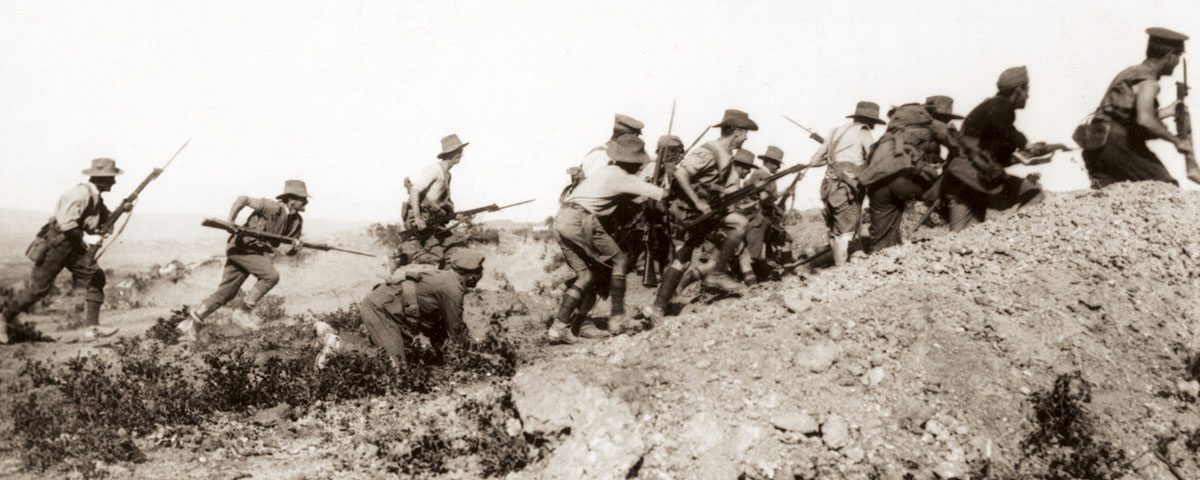Take, say, a rucksack, stuff it with poor leadership, bad timing, miscommunication and poor coordination among forces, political gamesmanship, overestimation of your own forces, underestimation of the enemy’s and steep uphill climbs against entrenched forces, and where would you pin it to the map?
Gallipoli.
Early in 1915, six months into World War I, the Western Front had locked into a stalemate, but the Russians were begging for help in the East, where Turkish forces had made headway in the Caucasus. Russia wanted the Allies to open a second front in the region and thus draw away the Turks. First Lord of the Admiralty Winston Churchill argued for a naval assault up the Dardanelles—the strait connecting the Aegean with the Sea of Marmara—to Istanbul, capital of the Ottoman empire.
Churchill thought a Royal Navy assault would sail through, once enemy mines were cleared, and the ships’ big guns would then wipe out Turkish forts lining the route. The Allied main fleet attacked in March 1915. But the British had not counted on Turkish mobile artillery. The minesweepers cut and ran, and remaining mines subsequently sank three Allied battleships—one French, two British. While the British dithered and London argued over what to do next, the Turks seized the opportunity to reinforce the Gallipoli peninsula. By the time British and French land forces attacked in late April, the Turks were entrenched on the spine running the length of Gallipoli. Establishing beachheads at the tip of the peninsula and partway up its Aegean coast proved costly for the Allies in lives lost.
By mid-July the battle had devolved into another trench warfare stalemate, made worse by the heat and disease. An August landing slightly farther north by a force of ANZAC (Australian and New Zealand Army Corps) troops failed to improve the situation. Back in London arguments raged about what to do next. Churchill was relieved as first lord but remained in the Cabinet. Not till December did the Allies quit. By then the Turks had suffered 300,000 casualties, the Allies 214,000. For the British the campaign was a huge embarrassment. The only success they enjoyed was the January 1916 evacuation—with no loss of life and only two wounded.
The poorly executed campaign ruined reputations and careers, though it did for a time relieve the pressure on Russia. The war ultimately toppled the already enfeebled Ottoman empire, but it also awoke latent nationalism, and the Turkish heroes of Gallipoli— notably Mustafa Kemal Atatürk, who became Turkey’s first president—went on to prominent positions in government. It did the same for Australia and New Zealand, which date their own rising national consciousness to April 25, 1915—first day of the land invasion of Gallipoli—still celebrated in both countries as Anzac Day.
Lessons:
■ Promote officers based on merit. The senior Royal Navy admiral in Gallipoli was indecisive and incompetent.
■ Coordinate your actions. The Royal Navy attacked before ground forces were ready to invade. They might as well have sent a telegram to the Turks, announcing their intentions.
■ Common sense counts. Why would Churchill assume the Turks wouldn’t protect the soft underbelly of the Ottoman empire, the Dardanelles? Hello?
■ Leaders must speak with one voice. When leadership at the top is divided, the confusion reaches all the way down to the cooks.
■ Think logistically. Both sides ran low on artillery shells, but the Turks were close to their source.
■ Overconfidence kills. The British arrogantly assumed they’d dominate the Turks, but their best turned out to be not very good.
■ Landing on a beach, then attacking uphill? Seriously?
■ Ambition isn’t leadership. The Russians had only asked for a demonstration, not a full-scale attack. But Churchill’s ego got the better of him.
Originally published in the March 2013 issue of Military History. To subscribe, click here.





